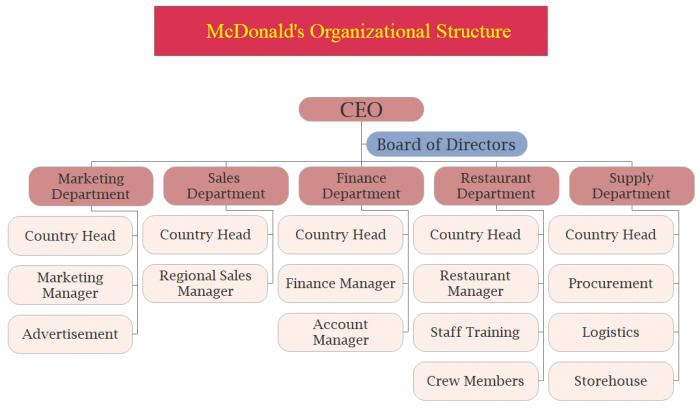Introduction
The type of organizational structure is an important element of the overall functioning of a company due to the dependence of job design and the achievement of company goals through the structural connections between employees. At McDonald’s, the hierarchical structure of the organization fits the company’s goals and mission since it is a clear, subordination-oriented, and controllable structural model. Indeed, since McDonald’s builds its competitive advantage on the standardization principles, the franchising of its facilities with the same principles and standards is only possible through a hierarchical structure. Figure 1 demonstrates the chart of the organizational structure used by McDonald’s.

Assessment of the Appropriateness of the Method of Departmentalization
The organizational structure at McDonald’s is designed on the basis of the method of geographical departmentalization. According to Williams et al. (2017), such an approach to forming departments within a company implies assigning responsible bodies within specific geographical units. Since McDonald’s is a global company with facilities in various countries, such a method is particularly appropriate. Indeed, the heads of geographical departments are given the opportunity to function according to the rules of business in a given country, which allows for a more successful localization of services and products (Williams et al., 2017). Thus, the choice of the departmentalization approach is reasonable and justifiable by the company’s global strategy and business model.
Implication for Authority
The hierarchal organizational structure with geographical departmentalization implies a particular mode of authority distribution. At McDonald’s, the structure of the company allows for a clear definition of a chain of command through the tracking of a vertical subordination of each lower-ranked unit to the higher-ranked ones, leading toward the CEO (Williams et al., 2017). The structure implies a significant role of centralized authority, according to which the control and decisions are executed under the management of the head unit, the CEO, and the Board of Directors. In such a manner, the power of making a decision within the realm of the responsibilities assigned to each employee in their respective departments is executed from top to bottom. This approach allows for better control and quality assurance of the completion of company tasks at all levels of operations and management. However, given the geographical departmentalization approach, McDonald’s structure implies a delegation of authority for the purposes of product and service localization.
Implications of the Current Organizational Structure for Job Design
The job design that is implied in such an organizational structure is job specialization. It means that each employee in their assigned positions performs strictly according to their responsibilities and tasks (Williams et al., 2017). Such an approach is validated by the standardization efforts and might be considered appropriate to the business model of McDonald’s. The benefit of job specialization is inherent in the ultimate productivity and effectiveness of performance at each position. Indeed, as stated by Williams et al. (2017), since the development of skills for task completion within the job specialization framework takes little time, repetition and excellence lead to successful performance. However, such a job design might be considered monotonous and diminish job satisfaction.
Conclusion and Recommendations
To summarize the evaluation of McDonald’s’ organizational structure, one might state that the selected hierarchical structure matches the company’s goals and mission. It allows for clarity in responsibility and authority distribution and allows for centralizing power while assigning clear tasks to each department. The geographical departmentalization method is validated by the global expansion of the franchised facilities standardized by the company. In such a manner, the departments of the organization in each country are equally overseen by the central branch of management. It also suffices a specialized gob design to ensure high standards and performance excellence at each position throughout the structure. However, there are several weaknesses in the evaluated organizational structure. In particular, they include the overload of managing positions that might have been avoided, as well as the excessive reliance on the job specialization that might compromise employees’ job satisfaction. Therefore, a set of recommendations is presented to improve the company’s opportunities through organizational structure changes.
Firstly, it is recommended to consider shifting the job design from job specialization to job rotation to allow the employees to differentiate their daily tasks, learn new skills, and contribute their potential creative to the company’s benefits. Indeed, within the current state of affairs, the employees in their assigned positions are limited to continuous performing of the same tasks multiple times per day, which might hinder their job satisfaction levels and ultimately diminish the effective performance of the whole department, branch, or company. Secondly, one might recommend McDonald’s to reconsider the positions in each of the departments to maximize the automation of processes that might be performed without human involvement. In such a manner, the company will be able to save on the costs of wages and advance the opportunities for consumer experiences. In such a manner, the company will manage to enhance its competitive advantage among rivals operating in the fast-food industry. Moreover, it will solidify the organization’s position in the market.
Reference
Williams, C., Champion, T., & Hall, I. (2017). MGMT: Principles of management (3d ed.). 4LTR Press.